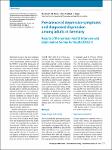Prevalence of depressive symptoms and diagnosed depression among adults in Germany
Results of the German Health Interview and Examination Survey for Adults (DEGS1)
Busch, Markus
Maske, Ulrike
Ryl, Livia
Schlack, Robert
Hapke, Ulfert
In the German Health Interview and Examination Survey (DEGS1), current depressive symptoms were assessed with the Patient Health Questionnaire (PHQ-9) in a representative population-based sample of 7,988 adults 18–79 years old. In addition previously diagnosed depression was assessed by physician interview. The prevalence of current depressive symptoms (PHQ-9 ≥10 points) is 8.1% (women 10.2%; men 6.1%). For both sexes, the prevalence is highest among 18- to 29-year-olds and decreases with age. Persons with higher socioeconomic status (SES) are less likely to have current depressive symptoms. The lifetime prevalence of diagnosed depression is 11.6% (women 15.4%; men 7.8%) and is highest among persons 60–69 years old. The 12-month prevalence is 6.0% (women 8.1%; men 3.8%) and is highest among 50–59 year olds. In women, but not in men, prevalences decrease with increasing SES. The results describe the distribution of two important aspects of depression among the adult population in Germany and confirm previously observed associations with age, gender and SES.
No license information

